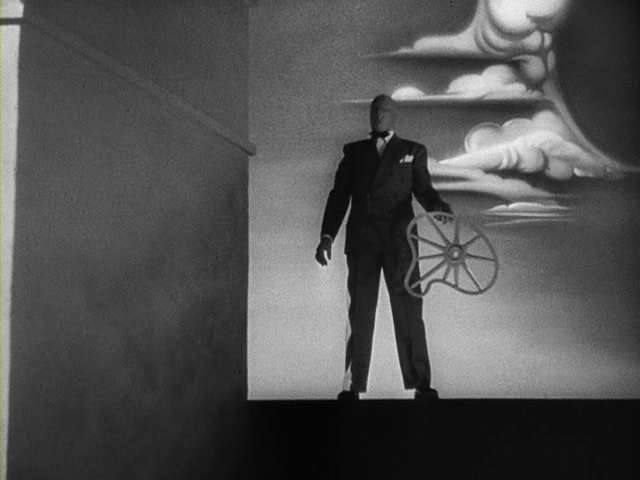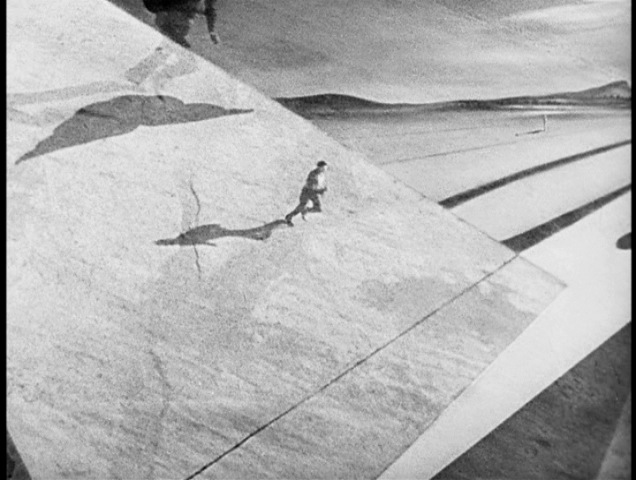Timelessness is held aloft as a standard by which we recognize a masterpiece. Ben Jonson wrote of Shakespeare ,"He was not of an age, but for all time", and while Jonson's eulogy may be slightly tongue-in-cheek, the observation has turned out to be a dead-on appraisal. Conversely, when a piece of work is described as "dated", it's not complimentary. Being "of an age" translates into "not aging well", and this is not a good sign for a book, play, musical composition, or film. But I found myself wondering, what does make something age well? Is it possible to be dated yet still be successful aesthetically? For a test case, I've chosen one of my favorite films from Alfred Hitchcock: Spellbound(1945).
Though it was a critical and commercial success at the time of its release(it received six Academy Award nominations, including one of Hitchcock's four director nods, and won for best score), Spellbound has subsequently experienced a drop in its esteem within Hitchcock's oeuvre. This is likely due to the movie's treatment of psychoanalysis; psychoanalytic theory was in vogue at the time in Hollywood cinema, often as a last-ditch effort to account for the actions of a demented criminal. From the vantage point of a few decades, it tends to seem laughable and silly. In a word, dated. But Hitchcock's film is saved from the slushheap of disregard where many a Freudian moon-calf has been relegated because of the way it uses psychotherapy: as a device, rather than as a subject. As Lesley Brill writes in The Hitchcock Romance, "Hitchcock uses psychoanalysis as another version of the romantic quest for identity. He finds its central assumptions, if not its scientific pretensions, wholly congenial. Since he has no particular interest in psychoanalysis as science, Hitchcock need not worry about his stylized condensation of the usual course of therapy or his excessively simple(from a realistic viewpoint) representation of the process of gaining access to the unconscious." (240) It is a tool for the telling of the story, and this is why an audience can forgive, nay, even enjoy, the ridiculousness of the motifs on display. They are in service of a grand, some may say grandiose, storyline of memory, danger, and romantic love.
All these qualities are showcased in a key early sequence. Dr. Constance Peterson (Ingrid Bergman) is unable to sleep, distracted by an attraction to the new institution head, (Gregory Peck), later revealed as an amnesiac suspected of murder--the only clue to his identity are the initials JB--. She gets out of bed and wanders up the staircase, light emanating from the closed door to his room; she turns away and goes to the library and picks up a book written by the man. But on the way back, the closed door beckons; she steps inside, finding him awake. They declare their love and kiss for the first time; beneath the sweeping orchestra of Miklos Rozsa’s score, the film cuts to an infinite series of doorways flying open, superimposing the image over the kiss. Is it subtle? Not in the least. Is it hokey? Perhaps. But does it also emerge as one of the great romantic moments in Hitchcock, if not classic Hollywood cinema? I would say yes.
| Opening quotation from the Bard, from Julius Caeser |
All these qualities are showcased in a key early sequence. Dr. Constance Peterson (Ingrid Bergman) is unable to sleep, distracted by an attraction to the new institution head, (Gregory Peck), later revealed as an amnesiac suspected of murder--the only clue to his identity are the initials JB--. She gets out of bed and wanders up the staircase, light emanating from the closed door to his room; she turns away and goes to the library and picks up a book written by the man. But on the way back, the closed door beckons; she steps inside, finding him awake. They declare their love and kiss for the first time; beneath the sweeping orchestra of Miklos Rozsa’s score, the film cuts to an infinite series of doorways flying open, superimposing the image over the kiss. Is it subtle? Not in the least. Is it hokey? Perhaps. But does it also emerge as one of the great romantic moments in Hitchcock, if not classic Hollywood cinema? I would say yes.
 |
| A doorway to new love? |
Hitchcock is often accused of
misogyny. By and large, I find these readings of his work to be simplistic and overblown(such interpretations of the films stem largely from poorly documented anecdotes presented by Donald Spoto in is his biography of the director, but that is a different topic). In his hefty filmography, several pictures feature women who ultimately prove to be very strong, often in the face of masculine threat. Spellbound is an indelible example of such a dynamic, as is Notorious(1946). Constance, frequently belittled and sexually propositioned by her male
colleagues and isolated by her position as a woman, nevertheless emerges as the film's formidable protagonist as she determines to discover the true identity of the man she loves and to
prove his innocence. She is the one who must protect and rescue him, using her
skills as an analyst to solve the murder and to cure his amnesia. Gregory Peck, young and beautiful, is placed in the somewhat odd position of being vulnerable and adrift
for much of the film. It isn't often that attractive masculinity is offered on display in the guise of threatened distress, in the 1940s or now. Their courtship provides an refreshing inversion of what the expected script of heterosexual romance typically would be.
 |
| Constance and JB |
One of the keys to unraveling JB's identity comes from Constance's analysis of his dreams. This sequence was designed by Salvador Dali, and the Spanish artist's involvement was crucial from the project's conception.As Patrick McGilligan observes in his mammoth biography of Hitchcock, "from the outset, Hitchcock envisioned turning the dreams over to the famed surrealist--holding back on the idea until the script gained acceptance with[producer David O.] Selznick...The opening of Un Chien Andalou shows an eyeball sliced with a razor; the Hitchcock script featured a man cutting painted eyes in half with a giant scissors."(355)
Though the sequence is shorter in the finished film than originally planned, and evidently was disappointing to Dali himself(most of Dali's preferred imagery was far too sexually explicit to make it past the Production Code office), the dream still emerges as a imaginative highlight of the film. The
visions of curtains with eyes, faceless card players and flying winged shadows would seem more at home in the early experimental work of a filmmaker like Luis Bunuel or Jean Cocteau than in an effort by a commercially successful Hollywood director.
While Hitchcock's Spellbound is undeniably a product of its time, it still has pleasures to offer in a vein that redeems it from obsolescence. That these pleasures arise from some of the very qualities that also make it dated may just have to be embraced instead of explained away.
 |
| Eyeball curtains, courtesy of Salvador Dali |
While Hitchcock's Spellbound is undeniably a product of its time, it still has pleasures to offer in a vein that redeems it from obsolescence. That these pleasures arise from some of the very qualities that also make it dated may just have to be embraced instead of explained away.
Sources
Brill, Lesley. The Hitchcock Romance: Love and Irony in Hitchcock's Films. Princeton University Press. 1988. Print.
McGilligan, Patrick. Alfred Hitchcock: A Life in Darkness and Light. ReganBooks. 2003. Print.



No comments:
Post a Comment